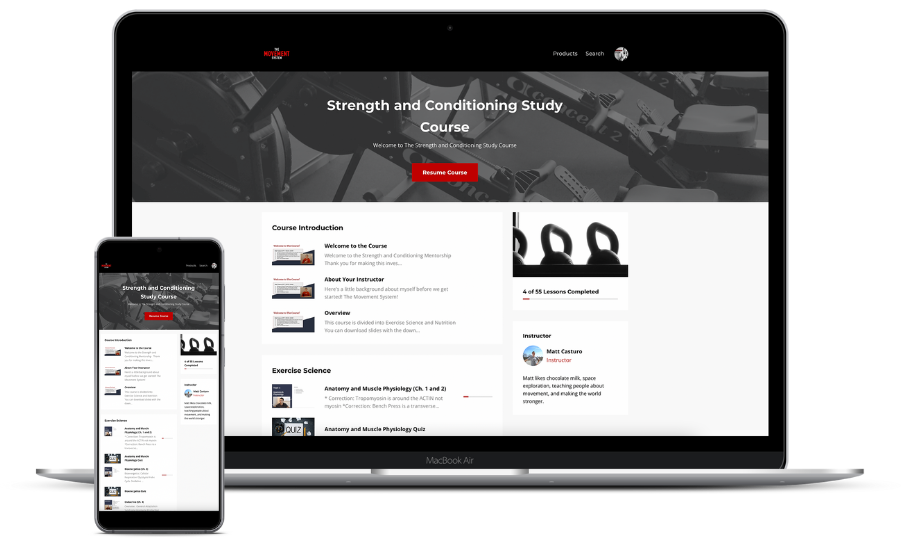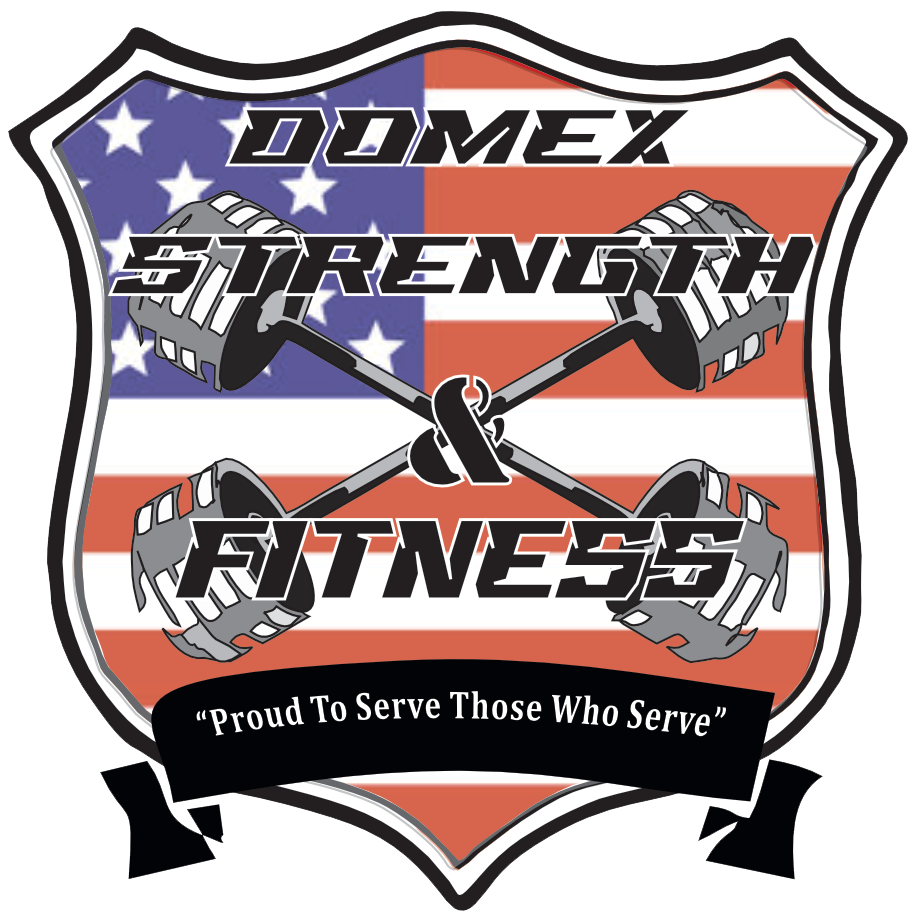Muscular Endurance Training Program for Career Longevity for the Tactical Athlete
With the DOMEX Strength & Fitness Prep Course

Save Time
This course provides step-by-step guidance through each DEA (PTA) chapter, ensuring you stay on the right path to pass the exam.

Save Money
Achieve cost savings by successfully passing the exam on your initial attempt.

Enjoy Studying
You'll breeze through challenging concepts when you discover how effortlessly studying can be.
Course Curriculum:
Course Overview:
Course Description:
How a tactical athlete training program prepares for functional fitness
Now that the job description and role of a ‘tactical athlete” is clearly defined, and why muscular endurance is needed for the tactical athlete, then how does an individual train like a “tactical athlete?” Some of the variables that need to adhered to when implementing a sound program design for a “tactical athlete” should be centered upon the following:
- Conducting training based upon a tactical athlete’s job description entails devising a program design for what they do through utilizing the three anatomical planes of human movement. All tactical athlete’s need to be able to efficiently move their bodies in the sagittal, frontal and transverse planes of motion. Training this way makes the tactical operator better equipped to successfully conquer any physically demanding task they encounter. Not only does this accomplish these objectives but equally important, assists the operator in aiding them in preventing Musculoskeletal (MSK) injuries. The three anatomical planes of human movement are the following:
- (A) Saggittal plane which separates the left and right sides of the body.
- (B) Frontal plane which separates the anterior and posterior of the body.
- (C) Transverse plane which separates the upper (superior) and lower (inferior) halves of the body.

“Tactical athlete” training through all 3 anatomical planes of human movement.
The following is a brief list of how a “tactical athlete” should center their training upon which takes into account of all three anatomical planes of movement. This is not an all-inclusive list but rather a representative sample of the desired movement patterns in order to elicit optimal physical performance.
- Resistance Training Exercise Techniques – Bench press, deadlift, squat, Romanian Deadlift, front squat, goblet squat, Farmers walk, push press, landmine press.
- Bodyweight Exercises: Pull/Chin-ups, push-ups, planks, TRX Bands, dead bar hangs, wall sits and unconventional methods such as sandbags.
- Flexibility and Mobility Exercise Techniques and Programming – Mobility is affected by one’s ability to move freely through coordination and without restriction. Flexibility does not indicate the ability of movement but rather the ability for one to develop a range of motion for ones muscles, ligaments and tendons. Stability is ability to maintain control of joint movement around its axis. Types of stretching – Static, ballistic and dynamic. It should be noted that “dynamic stretching” is considered one of the premium forms of stretching to be effected before conducting an exercise session as it raises the core temperature of the body in preparation for exercise. (Further explanations of dynamic stretching with examples can be found at our IG page of @Domexstrengthandfitness and linked articles on this website.)
Entry level components devised for today’s tactical athlete in law enforcement
The following is a program design of four workouts devised into a two-day upper and two-day lower body split to be conducted for anaerobic conditioning through resistance training. This routine will add a fifth day of muscular endurance training that can be programmed in as a
bodyweight day only with sandbags. Note for the body to make the physiological adaptations desired in a muscular endurance program, the repetition count and rest periods need to be followed closely that were mentioned above.
Anaerobic Muscular Endurance Exercise Programming
Program 1: Upper body – Day 1
*5-10-minute dynamic stretching * (walking toe touch, lunges, jumping jacks, side shuffles, see attached article on website on dynamic stretches and videos on Instagram account).

| Exercise: | Sets | Repetitions | Rest period | Goal |
|---|---|---|---|---|
| Dead Bar Hang | 2 | 20-30 seconds(S) | 30 | Muscular Endurance(ME) |
| Bench press | 4 | 12+ | ME | |
| Push-ups | 4 | 15-20 | 30-60 s | ME |
| Deadlift | 3 | 12+ | 30-60 s | ME |
| Standing Military Press | 3 | 12+ | 30-60 s | ME |
| Dumbell Curls | 3 | 12+ | 30-60 s | ME |
| Tricep Pressdown | 3 | 12+ | 30-60 s | ME |
| Planks | 3 | 30-60 seconds | 30-60 s | ME/Isometric Strength |
| 1 Arm Dumbell/Kettlebell Carries | 2 | 12-15 walking steps in total | 30-60 s | ME |
- Dead bar hangs will start at 20-30 seconds then subsequently make a linear progression to 45 then 60 seconds.
- A number followed by a letter denotes a superset, see above 2A and 2B.
- Isometric Strength exercise, #7, is when a muscle is neither lengthened (eccentric) or shortened(contracted).
- 5-10 minute static stretching cooldown after workout is completed*
Program 2: Lower body – Day 2
*5-10-minute dynamic stretching *(walking toe touch, lunges, jumping jacks, side shuffles, see attached article on website on dynamic stretches and videos on Instagram account).
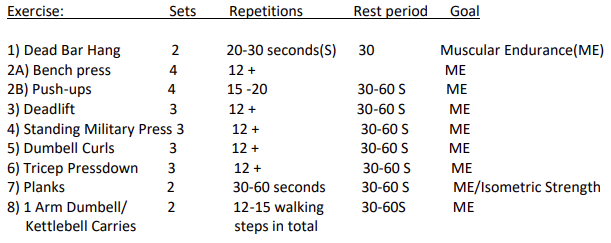
| Exercise: | Sets | Repetitions | Rest period | Goal |
|---|---|---|---|---|
| Back Squat | 4 | 12+ | 60s | Muscular Endurance(ME) |
| Trap Bar Deadlift | 3 | 12+ | 60s | ME |
| Leg Extension | 3 | 10-12+ | ME | |
| Rear Elevated Split Squat | 3 | 6-8 | 60s | ME |
| Romanian Deadlift (RDL) | 4 | 10-12+ | 45-60s | ME |
| Dumbell Calf Raise | 3 | 15 | 30-60s | ME |
| Wall Sits | 3 | 30-60s | 30-60 s | ME/Isometric Strength |
| Standing Knee Raises | 3 | 12-15 | 30s | ME |
| Oblique Twists w/Plate | 2 | 12 | 45-60s | ME |
- A number followed by a letter denotes a superset, see above 3A and 3B.
- Isometric Strength exercise, #7, is when a muscle is neither lengthened (eccentric) or shortened(contracted).
- 5-minute static stretching cooldown
Program 1: Upper body – Day 3
*5-10-minute dynamic stretching *(walking toe touch, lunges, jumping jacks, side shuffles).
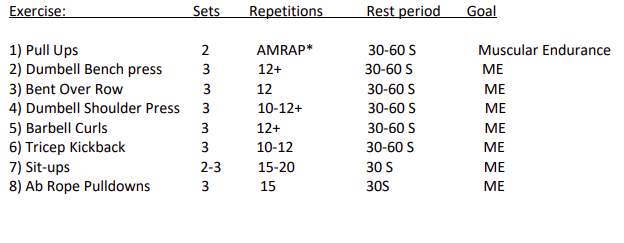
| Exercise: | Sets | Repetitions | Rest period | Goal |
|---|---|---|---|---|
| Pull Ups | 2 | AMRAP* | 30-60s | Muscular Endurance |
| Dumbell Bench press | 3 | 12 | 30-60s | ME |
| Bent Over Row | 3 | 12 | 30-60s | ME |
| Dumbell Shoulder Press | 3 | 10-12+ | 30-60s | ME |
| Barbell Curls | 3 | 12+ | 30-60s | ME |
| Tricep Kickback | 3 | 10-12 | 30-60s | ME |
| Sit-ups | 2-3 | 15-20 | 30s | ME |
| Ab Rope Pulldowns | 3 | 15 | 30s | ME |
- 1) AMRAP = As Many Reps as Possible.
- 5-minute static stretching cooldown.
Program 2: Lower body – Day 4
*5-10-minute dynamic stretching * (walking toe touch, lunges, jumping jacks, side shuffles).
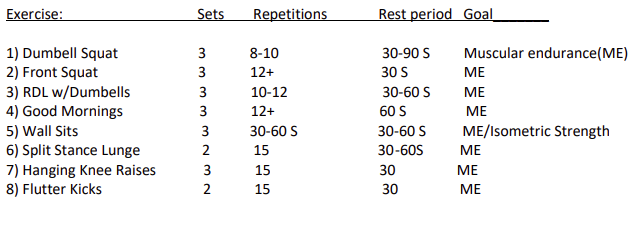
| Exercise: | Sets | Repetitions | Rest period | Goal |
|---|---|---|---|---|
| Dumbell Squat | 3 | 8-10 | 30-90s | Muscular Endurance |
| Front Squat | 3 | 12+ | 30s | ME |
| RDL w/Dumbells | 3 | 10-12 | 30-60s | ME |
| Good Mornings | 3 | 12+ | 60s | ME |
| Wall Sits | 3 | 30-60s | 30-60s | ME/Isometric Strength |
| Split Stance Lunge | 2 | 15 | 30-60s | ME |
| Hanging Knee Raises | 3 | 15 | 30 | ME |
| Flutter Kicks | 2 | 15 | 30 | ME |
- 5-minute static stretching cooldown.
Day 5 – Non-Conventional method training with sandbag.
- Sandbag Squats: 3 sets X 10 – 12 reps
- Sandbag Front Squats 3 X 10 – 12
- Sandbag Deadlifts 3 X `10-12
- Sandbag Lying
- Abdominal side to side twist 2-3 X 6-8
- Sandbag Standing straight arm front raise 2-3 X 6-10
- Sandbag weight and repetitions are dependent upon conditioning level and this is solely a guide.
- 5-minute static stretching cooldown.
The preceding depicts incorporating a tactical athlete training program for muscular endurance and its various benefits for optimal performance, prevention of MSK and their subsequent benefits contributing to career longevity. Through this vision, the tactical athlete can utilize, modify or adapt their strength and conditioning programs to aid them in becoming the best version that they can be.
Results vary depending on starting point, effort, and goals set for your vision. Exercise and proper diet are necessary to achieve and maintain weight loss, develop lean body mass, better your cardiovascular condition which are conducive to performing your best for what this program design is intended for. Consult your physician and follow all safety instructions before beginning this program as this program is educational and does not take the place of the advice of your personal health care physician. DOMEX Strength and Fitness is not a Physician, Physical Therapist, or Registered Dietitian. The services provided should not be taken as medical advice. It is not intended to diagnose, treat, cure, or prevent any health problem – nor is it intended to replace the advice of a physician. Always consult your physician or qualified health professional on any matters regarding your health. Lastly, the purchasing party of this program certifies that he or she is physically sound and suffering from no condition, impairment, disease, infirmity, or illness that would prevent the individual’s participation in this program. The contents on this program design are for informational purposes only, and are not intended to diagnose any medical condition, replace the advice of a healthcare professional, or provide any medical device, diagnosis, or treatment. Furthermore, the purchasing party of this program agrees to indemnify DOMEX Strength and Fitness, LLC, for any injuries, illnesses, or expenses from the individual’s participation.
